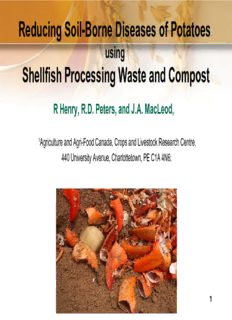
Reducing Soil-Borne Diseases of Potatoes Shellfish Processing Waste and Compost PDF
Preview Reducing Soil-Borne Diseases of Potatoes Shellfish Processing Waste and Compost
Reducing Soil-Borne Diseases of Potatoes using Shellfish Processing Waste and Compost R Henry, R.D. Peters, and J.A. MacLeod, 1Agriculture and Agri-Food Canada, Crops and Livestock Research Centre, 440 University Avenue, Charlottetown, PE C1A 4N6; Chitin – In Nature Insects and Arachnids Marine Invertebrates Fungi and Algae Chitin Structure Chitin non-toxic, biodegradable, naturally- occurring polysaccharide second most abundant natural polymer after cellulose Shellfish Processing Waste 14 – 35% chitin (dry weight basis) 2 - 4% Nitrogen 15 - 20 % Calcium Applications Health Care Food and Beverages • wound dressing and healing • preservative/stabilizer • surgical sutures • anticholesterol and fat-binding • arthritis • flavours and tastes • orthopaedics • pharmaceuticals • cosmetics Waste Treatment Agriculture • removal of metal ions • insecticides • purify drinking water • fungicides • pools and spas • seed, in-furrow, • product separation and • foliar and post-harvest recovery treatments Possible mechanisms of disease control antimicrobial properties stimulation of host resistance mechanisms enhance complement of beneficial bacteria and fungi - chitinolytic species – this work - competitive effects - direct antibiosis Successful disease control reports common scab of potato grey mold of fruits blue mold of fruits Fusarium crown and root rot of tomato green mold of citrus downy mildew of grapes powdery mildew Only a handful of registered products available. Objectives Is shellfish waste and shellfish waste compost an effective source of plant nutrition and biological control method for soil-borne fungi diseases of potatoes? Is disease suppression related to the complex of soil organisms? Methodology Cultivar: Superior (white skin and flesh) Field Treatment: A. raw lobster waste - 10,000 lbs/ac B. compost – 10,000 lbs/ac C. conventional fertilizer (control) 120 N Application: Banded or Broadcast Field Design: 4 replications, 6 plots/rep Making a seafood based compost, with moderate N release ability Lay down 12 inch bed of straw Add shell waste Cover with wet sawdust
Description: